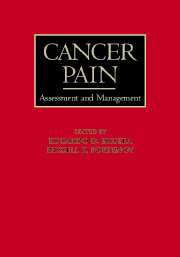Book contents
- Frontmatter
- Contents
- List of contributors
- Preface
- SECTION I MECHANISMS AND EPIDEMIOLOGY
- SECTION II ASSESSMENT AND SYNDROMES
- SECTION III PHARMACOLOGICAL TREATMENT
- 7 Pharmacology of analgesia: basic principles
- 8 Pharmacology of opioid analgesia: clinical principles
- 9 Opioid side effects and management
- 10 Nonopioid analgesics
- 11 Adjuvant analgesic drugs
- SECTION IV NONPHARMACOLOGICAL APPROACHES
- SECTION V THE ROLE OF ANTINEOPLASTIC THERAPIES IN PAIN CONTROL
- SECTION VI PAIN IN SPECIAL POPULATIONS
- SECTION VII DIFFICULT PAIN PROBLEMS
- SECTION VIII SPECIAL TOPICS
- Index
11 - Adjuvant analgesic drugs
from SECTION III - PHARMACOLOGICAL TREATMENT
Published online by Cambridge University Press: 08 October 2009
- Frontmatter
- Contents
- List of contributors
- Preface
- SECTION I MECHANISMS AND EPIDEMIOLOGY
- SECTION II ASSESSMENT AND SYNDROMES
- SECTION III PHARMACOLOGICAL TREATMENT
- 7 Pharmacology of analgesia: basic principles
- 8 Pharmacology of opioid analgesia: clinical principles
- 9 Opioid side effects and management
- 10 Nonopioid analgesics
- 11 Adjuvant analgesic drugs
- SECTION IV NONPHARMACOLOGICAL APPROACHES
- SECTION V THE ROLE OF ANTINEOPLASTIC THERAPIES IN PAIN CONTROL
- SECTION VI PAIN IN SPECIAL POPULATIONS
- SECTION VII DIFFICULT PAIN PROBLEMS
- SECTION VIII SPECIAL TOPICS
- Index
Summary
Introduction
The term adjuvant analgesic can be applied to any drug that has a primary indication other than pain, but is analgesic in some painful conditions. This term is often used synonymously with the term co-analgesic when it refers to a drug that is administered with another analgesic, usually an opioid. In the cancer population, this combination is usually administered to enhance pain relief when a syndrome is poorly responsive to the opioid, or to allow opioid dose reduction when opioid-related side effects are problematic. The adjuvant analgesics also may be considered a subset of a larger group of adjuvant drugs some of which are specifically co-administered with analgesics to treat side effects.
Rapid advances in basic and clinical pharmacology have dramatically expanded the role of the adjuvant analgesics. For this reason, the term adjuvant is actually a misnomer in many settings. Many of these drugs are used alone, as primary analgesics, when pain is likely to be responsive. This is particularly true in populations with chronic non-malignant pain. Given this expanding use, it is important to understand both the pharmacology of these drugs and their therapeutic role in the management of cancer pain.
General considerations
The effective use of an adjuvant analgesic depends on systematic assessment of the patient. This assessment clarifies the nature of the pain, infers pain pathophysiology, identifies a specific pain syndrome, and allows an understanding of the pain as one of potentially numerous problems that may undermine quality of life. Over time, repeated assessments must track changes in pain, side effects, or any of the broader quality of life concerns may impel a shift in therapeutic strategy.
- Type
- Chapter
- Information
- Cancer PainAssessment and Management, pp. 188 - 198Publisher: Cambridge University PressPrint publication year: 2003
- 1
- Cited by



